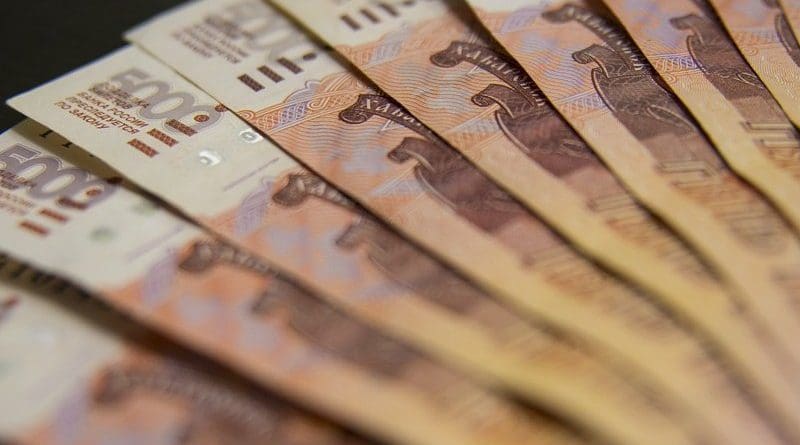How India And China Revved Up Russian Resilience To Economic Distress – Analysis
Arguments, debates and surprises spun on Russia circumventing set back to the economy, like recession or stagnation, even after continuing war with Ukraine over a period of one year, coupled with sanctions by most rich nations. In contrast, Germany went under recession, owing to the Ukraine war. About 37 countries have imposed sanctions on Russia since the invasion of Ukraine in February 2022.
Russia’s economy shrank by 2.1 percent in 2022, but was positive for the bounce back in 2023. According to latest IMF outlook, GDP of Russia is expected to inch up by 0.7 percent in 2023. These demonstrate that Russian economy avoided recession, unlike Japan and Germany, which are more damaging to the economy in longer term.
Russia is the 8th largest economy by nominal GDP and 6th largest economy by PPP. Oil and gas accounted for about 40 percent of Russia’s federal Budget Revenue and 60 percent of exports in 2019.
The underlying factors leveraging Russian resilience to economic distress were energy trade and partisan in the global trade. Buoyancy in trade with India and China played a key role in boosting Russian resilience. Surging imports by India and China from Russia triggered revenue exchequer to save the economy from the distress.
In 2022-23, India’s imports from Russia spurred by 368.2 percent. It is a consequential leap over and above the spur in imports in the preceding year. India’s imports from Russia increased by 79.9 percent in 2021-22.
So did the China’s bubbling growth in imports from Russia. In 2022, China’s imports from Russia leaped by 43.4 percent. For the first time, Russia became one of the top ten trade partners of China. Much to the surprise and which is unusual, China borne the trade deficit with Russia. In 2022, China’s import from Russia was US$114.5 billion, against export of US$76.1 billion, leaving much cushion to Russia to earn revenue to tide over the war and sanction fall out.
In both the cases, energy was the primary reason for surge in imports from Russia.
During 2 years period preceding Ukraine invasion ( 2020 and 2021), annual average of oil export by Russia to the world was about 261.5 million tonne. Assuming the same amount of export was generated in 2022, India and China accounted for nearly 50.5 percent of Russia’s total oil export, against 39.1percent in 2021. Of these, China accounted for 32.9 percent and India 17.6 percent shares.
Even though China accounted for more share in import of crude oil from Russia in 2022, in terms of growth, India excelled China. In 2022, China imported 86.3 million tonne, as compared to 79.6 million tonne in 2021, showing a growth by 8.4 percent in 2022. In contrast, India’s import of crude oil from Russia made an whopping jump by 2,605.9 percent in 2022- from 1.7 million tonne in 2021 to 46.0 million tonne in 2022. These demonstrate that India has played a more active role in revving up Russia’s revenue budget, despite the war and sanctions.
Conversely, Russian oil made a predominant entry in Indian oil basket. From merely 4 percent in the oil basket, Russian share in the Indian oil basket leapfrogged 20 percent in 2022-23. This manifests a new era with a major shift to Russia, leaving OPEC in the back bench for import of oil.
To tide over the sanctions, India and Russia have set up alternative arrangements. Indian refineries have accepted Russian insurance. Russian oil suppliers are trying to handle Urals oil transport to India themselves, using their own vessels and shipping arrangement.
Besides oil, India’s large imports of fertilizer kept Russian coffers supplemented by enhancing revenue. India’s import of fertilizer from Russia increased by 293.9 percent in 2022-23, in value term. Oil and fertilizer accounted for 73.7 percent of total import of India from Russia in 2022-23 , as compared to 32.9 percent in 2021-22. This manifest that it is not only in energy, but in agricultural development also Russian cooperation has become imperative.
De-dollarization has become a timely support to Russia to seize in sanctions. The fall out led to global partisan in trade, leading shadow on the prominence of dollar based trade. Nearly 75 percent of China’s import from Russia in 2022 was settled in Chinese currency yuan.
Following suit, India revived its Rupee trade arrangement with Russia. Indian government permitted nine Indian banks to open vostro accounts with Russian banks. This will facilitate to deal with Russian oil in rupee trade in currency swapping deal. Indian UCO bank has opened the vostro accounts with Russian Gazprombank and VTB banks.
In summing up, Russian vulnerability as a trade partner has been hyped a paranoia, rather than unfolding the benefits. India saved US$3.6 billion by importing oil from Russia in the first ten months of 2022-23, according to the statement by the Minister. Should India have second thought focussing on Russia and de-dollarization as a new wave for trade diversification?


however, Russia is stuck with billions of Indian rupees Indian banks. Russia may have no alternative use for the rupees except for trade with, and investment in India. However, Russia is the surplus country. They may not be willing to invest in India. The Russia foreign.minister, Lavarof, said they need the money and they do not know what to do with billions of rupees!